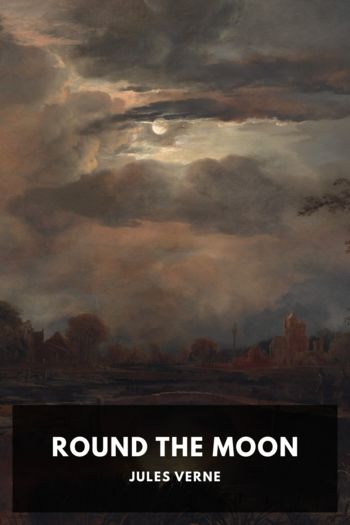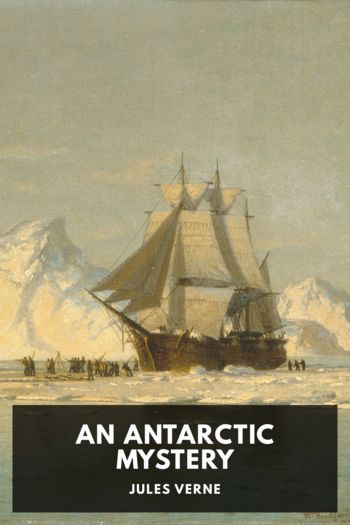Round the Moon by Jules Verne (read aloud txt) 📕

- Author: Jules Verne
Book online «Round the Moon by Jules Verne (read aloud txt) 📕». Author Jules Verne
This fresh work was ended about 3 p.m., and all precaution taken they had now nothing to do but to wait.
In the meantime the projectile visibly drew nearer the moon. It was, therefore, submitted in some proportion to its influence; but its own velocity also inclined it in an oblique line. Perhaps the result of these two influences would be a line that would become a tangent. But it was certain that the projectile was not falling normally upon the surface of the moon, for its base, by reason of its weight, ought to have been turned towards her.
Barbicane’s anxiety was increased on seeing that his bullet resisted the influence of gravitation. It was the unknown that was before him—the unknown of the interstellar regions. He, the savant, believed that he had foreseen the only three hypotheses that were possible—the return to the earth, the fall upon the moon, or stagnation upon the neutral line! And here a fourth hypothesis, full of all the terrors of the infinite, cropped up inopportunely. To face it without flinching took a resolute savant like Barbicane, a phlegmatic being like Nicholl, or an audacious adventurer like Michel Ardan.
Conversation was started on this subject. Other men would have considered the question from a practical point of view. They would have wondered where the projectile would take them to. Not they, however. They sought the cause that had produced this effect.
“So we are off the line,” said Michel. “But how is that?”
“I am very much afraid,” answered Nicholl, “that notwithstanding all the precautions that were taken, the Columbiad was not aimed correctly. The slightest error would suffice to throw us outside the pale of lunar attraction.”
“Then the cannon was pointed badly?” said Michel.
“I do not think so,” answered Barbicane. “The cannon was rigorously perpendicular, and its direction towards the zenith of the place was incontestable. The moon passing the zenith, we ought to have reached her at the full. There is another reason, but it escapes me.”
“Perhaps we have arrived too late,” suggested Nicholl.
“Too late?” said Barbicane.
“Yes,” resumed Nicholl. “The notice from the Cambridge Observatory said that the transit ought to be accomplished in ninety-seven hours thirteen minutes and twenty seconds. That means that before that time the moon would not have reached the point indicated, and after she would have passed it.”
“Agreed,” answered Barbicane. “But we started on the 1st of December at 11:13:25 p.m., and we ought to arrive at midnight on the 5th, precisely as the moon is full. Now this is the 5th of December. It is half-past three, and eight hours and a half ought to be sufficient to take us to our goal. Why are we not going towards it?”
“Perhaps the velocity was greater than it ought to have been,” answered Nicholl, “for we know now that the initial velocity was greater than it was supposed to be.”
“No! a hundred times no!” replied Barbicane. “An excess of velocity, supposing the direction of the projectile to have been correct, would not have prevented us reaching the moon. No! There has been a deviation. We have deviated!”
“Through whom? through what?” asked Nicholl.
“I cannot tell,” answered Barbicane.
“Well, Barbicane,” then said Michel, “should you like to know what I think about why we have deviated?”
“Say what you think.”
“I would not give half a dollar to know! We have deviated, that is a fact. It does not matter much where we are going. We shall soon find out. As we are being carried along into space we shall end by falling into some centre of attraction or another.”
Barbicane could not be contented with this indifference of Michel Ardan’s. Not that he was anxious about the future. But what he wanted to know, at any price, was why his projectile had deviated.
In the meantime the projectile kept on its course sideways to the moon, and the objects thrown out along with it. Barbicane could even prove by the landmarks upon the moon, which was only at 2,000 leagues’ distance, that its speed was becoming uniform—a fresh proof that they were not falling. Its force of impulsion was prevailing over the lunar attraction, but the trajectory of the projectile was certainly taking them nearer the lunar disc, and it might be hoped that at a nearer point the weight would predominate and provoke a fall.
The three friends, having nothing better to do, went on with their observations. They could not, however, yet determine the topography of the satellite. Every relief was levelled under the action of the solar rays.
They watched thus through the lateral windows until 8 p.m. The moon then looked so large that she hid half the firmament from them. The sun on one side, and the Queen of Night on the other, inundated the projectile with light.
At that moment Barbicane thought he could estimate at 700 leagues only the distance that separated them from their goal. The velocity of the projectile appeared to him to be 200 yards a second, or about 170 leagues an hour. The base of the bullet had a tendency to turn towards the moon under the influence of the centripetal force; but the centrifugal force still predominated, and it became probable that the rectilinear trajectory would change to some curve the nature of which could not be determined.
Barbicane still sought the solution of his insoluble problem. The hours went by without result. The projectile visibly drew nearer to the moon, but it was plain that it would not reach her. The short distance at which it would pass her would be the result of two





Comments (0)